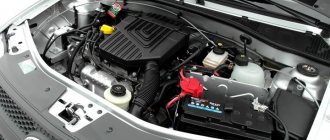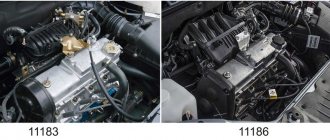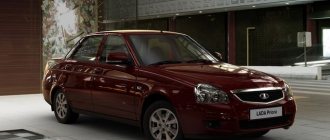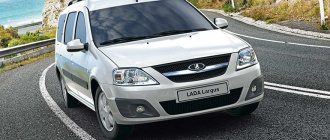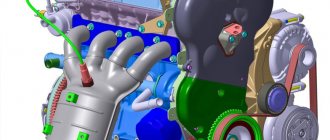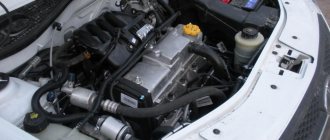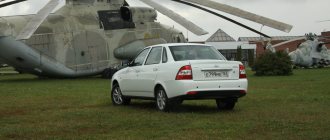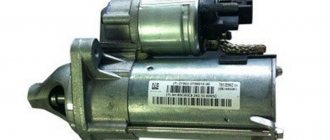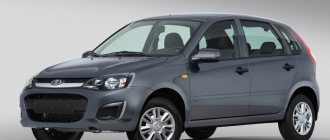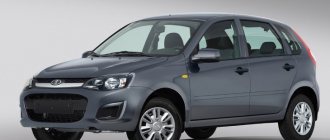The Lada Largus 8-valve engine is the most optimal and practical version of the power unit for the Russian station wagon.
At the very beginning of production, the Lada Largus was equipped with an 8-valve Renault engine. You can find this engine under the hood of a Renault Logan or Sandero. The name of this unit is K7M. Subsequently, it was decided to abandon the K7M in favor of the Russian VAZ-11189 engine.
This was done for several reasons. Firstly, the K7M engine was imported from Romania, and due to the weakening of the ruble, this power unit has increased significantly in price. Secondly, the K7M was initially weak for Largus. And due to the transition to Euro-5, it would have to be “strangled” even more, which would inevitably lead to a loss of power. In order not to completely abandon the 8-valve version of the engine for Largus, it was decided to rework the VAZ engine that had been available since the distant 80s.
What engine is Lada Largus 8 valves?
The Lada Largus engine has 8 valves and has the VAZ-11189 index. Not to say that this is a completely new engine. But a significantly modified VAZ 8-valve. Firstly, the engine was completely redesigned for the Lada Largus. Therefore, we started by completely changing the engine mounts in order to comfortably place it under the hood of a station wagon.
Next, all attachments were replaced - generator, power steering pump, air conditioning compressor. Also
The piston group was replaced and completely redesigned, which now includes lightweight connecting rods and pistons. In addition, many modifications had to be made to fit the Russian engine under the hood of the station wagon. For example, change the electrical wiring, lay hoses, change the intake and exhaust systems, move the battery and washer reservoir, etc.
Technical characteristics of the VAZ 21129 1.6 16kl engine
| Type | in-line |
| Number of cylinders | 4 |
| Number of valves | 16 |
| Exact volume | 1596 cm³ |
| Cylinder diameter | 82 mm |
| Piston stroke | 75.6 mm |
| Supply system | injector |
| Power | 106 hp |
| Torque | 148 Nm |
| Compression ratio | 10.5 – 11 |
| Fuel type | AI-92 |
| Environmental standards | EURO 5 |
What is the 8-valve engine of Lada Largus 11189?
Engine 11189 is a kind of logical continuation of the VAZ-11183 engine, which you could find in cars such as Granta or Kalina. However, it has a slightly higher output of 87 hp. instead of 82 hp As I said above, this was achieved thanks to the installation of a new lightweight piston group from Federal Mogul. Of course, it was not possible to shoot 11189 of any high power, but this was not planned. The station wagon needed a simple and reliable unit that would not take the owner out of his head.
Lada Largus
Now all Largus without exception have cabin air filters
Now all Largus without exception have cabin air filters
Since we have already taken up the engines of the Largus family, why not reconsider the level of equipment? Now all cars have athermal glass, cabin air filters and a seat belt warning light. Instead of a cigarette lighter there is a universal 12 V socket. The windshield wiper mechanism has been improved, thanks to which it was possible to get rid of the “French tear” - a characteristic smudge in the center of the windshield. A more efficient vacuum booster has appeared in the brake system - from ATE. The configurations have also been slightly adjusted: previously, only the Lux modifications were equipped with the 16-valve K4M engine, but now they can also be found on the Norma.
In general, concern for the environment helped Largus improve its power characteristics and not lose its price attractiveness.
PLUS:
The new engine will increase interest in basic cars
MINUS:
Largus has not become more expensive with our engine - but why hasn’t it become cheaper?
Lada Largus with VAZ-11189 engine: plus three forces for rubles
Engine design 8 valves Lada Lagrus
If you have ever owned a VAZ car, then you can already imagine how the 8-valve VAZ Lada Largus engine works.
This is a cast iron block that resists wear well. Aluminum cylinder head and valve cover, as well as a pan made of steel.
Number of cylinders - 4, number of valves - 8.
The timing drive, traditionally for Russian front-wheel drive cars, is belt driven. This made it possible to reduce the noise of the engine, but at the same time reduced the life of the belt. Although replacing the Lada Largus timing belt and rollers is a simple procedure that can be performed even in any garage.
There are no hydraulic compensators in this engine. Their installation would have increased the cost of the design, so the factory abandoned them. Valve clearances are adjusted using special shims. This procedure should be carried out at least once every 30 thousand kilometers. In general, such work will not hit your pocket hard, since there are plenty of specialists, and adjusting washers are available in different sizes for quite reasonable money.
The intake manifold is plastic, the exhaust has a cat manifold. The throttle is electronic.
Injection - distributed through injectors in the fuel rail.
Lada Largus - owner reviews
Yuri
I’ve owned a Largus for 7 years, I took it for work, we deal with vegetables. The engine is 8 valve and the dynamics are not enough, but I’m not a fan of drive, but for a family it’s a good roomy car, I’m very, very happy, the mileage is 149 thousand km. Wherever I’ve driven, the car has never let me down. Maybe someone you won’t like my review, but I’m tired of reading lies about Largus. I change consumables on time and there are no problems. I carry loads from 400 kg to 700 kg. I often change tires; I don’t drive more than 50 thousand. During this time I replaced the battery, although the pump was possible to drive. clutch. gas costs. I adjust the valves after 30-40 thousand. Mileage. the air conditioner works great. the car doesn’t rot. and if I decide to change it, I’ll take it. Again, Largus, I don’t know how to take it with the VAZ engine?
Lyokha
Who paid you for this misinformation? Norm Largus. I didn’t do anything for 60,000 km. I installed HBO and it works! I’ll waste DrZ will be even cooler! If it’s petrol, then only AI-95, the internal combustion engine on it opens and pulls!!!
Dmitriy
Largus three years old, 7 seats, 84 hp. Drove 40 t.km. After 10 t.km I installed gas equipment (propane, a cylinder instead of a spare tire). I travel around Moscow, to the dacha, once a year - to the south, to the sea. Overall I like the car.
Pros: 1. Capacity. 2. It hasn't broken yet. Over the entire period, only one light bulb was replaced. 3. Comfortable fit (but this, of course, is different for everyone, since there are few adjustments). 4. Excellent chassis - it never breaks, it “swallows” bumps.
Cons: 1. Very large turning radius. It is very inconvenient to park or get out of difficult places. 2. The gear ratios in the gearbox are poorly selected; 4000 rpm at 120 km/h is too much. 3. Due to such speeds, the result is high fuel consumption. Therefore, only gas solved the issue of the cost of the trip. 4. Poor sound insulation. Combined with high revs, this leads to noise in the cabin.
In general, an excellent family and country car for its price category.
https://wroom.ru/story/id/19063
Evgenii-TMSK
This review is more dedicated to those who choose a Lada Largus car for purchase. I will try to be objective and not load too much information, as they say - “more meat, less dough.”
Briefly about yourself: 35 years old, driving license since 18, family, 2 children. Driving experience: first car 2106, then while I lived in the Far East there were different variants of right-hand drive, then left-hand drive: Getz, Lacetti, Octavia Tour, Granta, Lancer 9.10, Polo sedan. In short, there is something to compare with.
Reasons for purchase:
- the most important thing is the Polo sedan, bought in May 2014, turned out to be very cold with the onset of frost in December (down to minus 15 is still bearable, if it’s colder, then you need to drive for about forty minutes to get warm. From home to work about 20-30 minutes in traffic jams, car I categorically wanted my wife and I to prolong our youth :)) - in short, I rode without taking off my gloves with a always fresh face. Plus, during the first severe frosts, at 40,000 miles, the front suspension began to rumble and the engine began to make unpleasant metallic sounds, about which much has been written on forums and various articles. Everything described above began to bother me and I decided that I needed to change the car).
- the winter was very snowy and driving in the yard and on polo roads became very problematic, almost every day I used a shovel to clear the exit from the yard - I needed something higher
- the crisis that came along with the frosts in December 2014 - there was nothing special to add to a good car, a loan was not considered. In the end, I decided to sell the Polo for 500 thousand, add a little and buy some kind of crossover, even with right-hand drive and front-wheel drive. The New Year holidays have arrived, car prices have already jumped. I spent several days rummaging around in the car, looking at X-trails, RAFiki, Foriki 2004-2006. I didn’t find anything sensible in 500-550, mostly worn-out cars with a bunch of owners, a bunch of mileage, etc., which will require a decent investment upon purchase, and the final price will ultimately be high.
I accidentally came across a LARGUS CROSS in Togliatti, price 493,000, good appearance, normal equipment, decent ground clearance - I wonder what kind of car it is. On January 5, 2015, I went to a Tomsk car dealership to look at this car, but they told me that this car would not be expected until April-May and the price would eventually be higher. It's a pity . They offered a regular Largus 2015 in the maximum configuration from stock at the price of 2014, which differs from the cross only in wheels, upholstery and moldings. I didn’t have any money, they didn’t want to take me to the trade-in polo, but the manager called some acquaintances who were outbid, who 15 minutes later took the polo in the wake of rising prices for 500,000, without even haggling.
On January 5, 2015, I went to a Tomsk car dealership to look at this car, but they told me that this car would not be expected until April-May and the price would eventually be higher. It's a pity . They offered a regular Largus 2015 in the maximum configuration from stock at the price of 2014, which differs from the cross only in wheels, upholstery and moldings. I didn’t have any money, they didn’t want to take me to the trade-in polo, but the manager called some acquaintances who were outbid, who 15 minutes later took the polo in the wake of rising prices for 500,000, without even haggling.
As a result, the purchase turned out to be very unexpected and emotional. On January 15, I picked up Largus from the salon with an alarm system installed and winter tires. I bought soft rubber carpets at the market. First impressions: the car is large, spacious interior, good visibility, high seating position, like a crossover, comfortable to sit in, high roof, engine is not loud, sound insulation is not annoying. The engine is responsive, the gearbox turns on clearly, the shifts are soft, the clutch grabs almost immediately, the pedals are soft - your legs don’t get tired. The operation of the gas pedal is understandable - a regular cable, the braking is also understandable - the ABS does not work unnecessarily. The steering wheel is moderately heavy - normal, the car does not steer perfectly, but quite predictably. In the city you often have to change gears (short gears), although you quickly get used to it; at 60 you can go in 5th gear. On the highway at 100 km/h at 5th 3000 rpm, when overtaking you don’t have to switch to 4th because there is enough torque. Consumption on the highway was 6.5 liters, in the city in the winter, taking into account warming up, it reached 12.5 liters, in the summer it became around 9 liters, I only refueled with 92nd. In winter I didn’t set it to autostart, the car started without problems even at minus 37 from the key fob. I started it before going out, went out while I was clearing the snow, the car warmed up to operating temperature, in no more than 10 minutes. For the winter I installed Korean tires MARSHAL 195/65 R15, the car became 1 cm higher, it does not affect consumption and the warranty in any way.
It’s worth mentioning the ground clearance: on this car, especially with 195/65 R15 tires, it can be compared to a crossover. The thresholds are high, the overhangs are small, throughout the entire winter I never got stuck anywhere or caught anything. You confidently drive through small snowdrifts and drive along snowy tracks without strain. In winter it’s warm in the car, even in cold weather I didn’t turn on the fan more than 2, only on the highway I set it to 3, because the rear windows were clouded. The heated seats work well, the operating algorithm is the same as that of a thermopot: when heated, it turns off. I won’t write about the controls, everything is the same as on Logan, nothing new. I got used to the control buttons in a couple of days, except for the sound signal button, which is located on the side of the switch. The suspension is tight and well-knit, we pass potholes, rails and other troubles of our roads without hysterics or bad emotions, only the rear beam thumps a little in the potholes (not much noise). In general, the feeling from the suspension is as if you were driving a crossover. Well, that's probably enough.
ADVANTAGES OF CAR:
- This car is still a Renault, only a nameplate from a VAZ;
- reliable, time-tested, cast-iron K4 M engine with easy repairs and cheap spare parts, like the whole machine;
- Good ground clearance
- Spacious transformable interior (plastic, by the way, does not creak anywhere); 5) Strong suspension;
- Quite liquid on the secondary market;
- Unstoppable.
MINUSES:
- Wheelbase is too long - difficult to maneuver in confined spaces;
- With such a wheelbase, the rear sofa is located close to the front seats (it would be nice to install a slide and move it);
- The roof rails have not been of any use to me and make it difficult to clear snow in the winter.
https://otzovik.com/review_1548946.html
alz177
I've already been driving my new Largus for 8 months. During this time I drove 16,000 km. After the purchase, he very easily and quickly “took root” in our enlarged family)) Before that we drove a Lada Kalina, and we no longer fit into it)) During this time we also managed to go on long trips (from Moscow to Anapa) and went to nature (had to skid in the sand). The overall impression of the car is very, very positive. There are a lot of advantages and it is impossible to list them all; I will only describe what I liked the most. Advantages: Huge interior and trunk, I was never able to load it completely, even when we were driving south, there were 5 people sitting in the cabin and the trunk was almost completely filled, but there was still space left and everyone was comfortable. I thought about buying a roof rack, but I didn’t have to, so everything fit. The placement of the spare wheel (under the body) was well thought out; there was no need to change it, but if you need to change it, there is no need to unload the entire trunk. For all 8 months I just drove and enjoyed the ride, I didn’t have to do anything (repair) at all. During this time, I had to replace only 2 low beam lamps (they burned out exactly 6 months later, both at once, maybe they were programmed that way))) and with the arrival of winter, pour anti-freeze into the tank and that’s it!!! New 7-seater car!! was purchased for 450 thousand rubles - a very good price for such a car. The basic configuration has air conditioning, airbags, heated seats, but there is no on-board computer, I got used to it in Kalina))
Flaws:
Expensive maintenance, from an official dealer it costs 5300 rubles. I didn’t do this, I changed the oil for 300 rubles (+ oil 1050 rubles + filters 500 rubles), though there will be no guarantee now, but I don’t think it will be needed, I think this car is quite reliable. With the arrival of winter, the interior takes a long time to warm up, but this is perhaps not a drawback of the stove, but the fact that the interior is so large and takes a long time to warm up. I'll go, maybe I'll add something later))
https://www.drom.ru/reviews/lada/largus/336677/
Mikhail
Hello dear readers! I want to share my opinion, accumulated over 97 thousand miles. I bought a new one. The previous one (VAZ2107) somehow made it from the market to my house. Its seller swore that it was the best in the entire market, and I considered myself a super expert in cars... In general, a year later I traded it in and took a Largus in the luxury. I’ll start from the beginning. I immediately decided to change the engine oil after 7500 km (which I don’t regret). After the run-in, a high-speed 5th gear pair was installed and the car began to delight on the highway with a comfortable ride.
I did not refuse the warranty, although they only replaced the speaker in the driver's door (I accidentally filled it with water when I was washing it) and the burnt-out button with the power window light. For some reason, the timing belt and rollers need to be changed after 120 thousand, although on French cars with the same engine after 60 thousand. Result: the video whistled at 88 thousand. I also changed the oil in the gearbox and gearbox at 30 thousand. on expensive ones. At the 90 thousand service, the left ball joint was replaced. That's all. The remaining consumables were changed according to the maintenance. The first year, out of habit, I wanted to finish something, but there was nothing to finish. I wouldn't call the car a beauty. This is a budget all around, but a cut above the 10th generation. I am not pretentious and look more at other qualities, and there really are a lot of them.
When running over long distances (800-1200 km), it doesn’t hurt your back, and you can continue to do other things. I drive a 95 + stitched “brains” and a 16-valve engine, everything is smooth, I think it’s not enough for such a body. You have to travel a lot (50-60 thousand per year). Often with a car full of passengers.
I am pleased with the car for its inexpensive operation, reliability, options, spaciousness, and versatility. For me, this is the best budget option.
https://www.drom.ru/reviews/lada/largus/87165/
rodof
I had my eye on this car for a long time and bought it in February 2014 for 463,700 rubles in a luxury configuration without casting and a leather steering wheel. By now I have driven about 15,000 km and in general I am happy with the car, with the exception of some points. Pros:
- Healthy interior: my first car in which I don’t rest my head on the ceiling in a fur hat, full-fledged seats on folding seats in the trunk (with my dimensions of 184 cm105 kg I could easily go on a long journey - 500 - 1000 km in one of these seats in the trunk ), and a huge trunk with the seats folded in the trunk - covers my gardening needs by 200% (with the seats folded out in the trunk, there is essentially no trunk - you can only put a couple of bags - for this case, a 500-liter roof rail trunk was purchased at the Largus store , but I haven’t tried it on yet - there was no need).
- The engine is like an engine - it spins willingly from 2500 rpm - there is no lack of traction at the bottom when empty, when fully loaded it forces you to tuck the lower gear more often, in general, the ordinary 16 - valve valve, suits me, there are hydraulic compensators - there is no need to adjust the valves. Empty, it allows you to play around in city traffic thanks to the “short” box.
- Transmission: I can’t say anything about the service life of the struts yet (low mileage), but in terms of penetration it’s quite good - on the dead section of the Salym - Uvat road it allows you to stay faster than the flow, occasionally overtaking even SUVs (in general it goes well on the highway - most likely due to the long bases). Loading capacity - a potato harvest of 178 buckets was safely transported to storage twice with the seats folded down, and with this overload there was still some small suspension travel left (all previous cars in this mode of operation sat safely on the bumpers and scraped the mudguards on the asphalt). After installing the gas equipment, to compensate for the weight of the gas equipment, spacers from Nexia were installed by +4 cm and the car was raised from the factory parameters by 1.5 - 2 cm. When fully filled with gas and gasoline, to compensate for zero it was possible to get by with spacers of +2 cm. but under my periodic severe operating conditions, I think it will not be superfluous. The box in this configuration is equipped with a cable drive and is stuck in much more clearly and easily when compared with the drive on the rods of front-wheel drive vases.
Minuses:
- The most important disadvantage is fuel consumption, if with my driving style all previous front-wheel drive VAZs (both 8 and 16V) consumed somewhere around 10 l100 km in the city, then the Largus consumes 11.5 - 12 l100 km in the city and met 8.4 liters at a leisurely pace driving (100 -120 km/h) on the road from Nizhnevartovsk to Tyumen. In Tyumen, a BRC gas system was installed and in terms of gas consumption there is no significant operating time yet, so far I can say the city is somewhere around 14.5 - 15.5 l100km, there are no stable operating hours on the highway. According to my estimates, the high consumption is due to the heavy weight of the car, poor aerodynamics (large car profile and chopped rear) and short gearbox (at a speed of 100 - 110 mph the engine develops about 3500 rpm, which is undoubtedly too much for cruising speed on the highway). It should be mentioned that gear sets with a longer 5th gear are sold on the Internet, it’s easy to change there - you don’t need to remove the gearbox, like strangling a toad - I’ll buy it and change it.
- Interior ergonomics: with the convenience of turning on the seat heating buttons and power window buttons, we go back to the 90s (99 vases with self-installed power windows, then it was cool, now it sucks), the driver’s seat is somewhat reminiscent of the seat from the VAZ five and despite the height adjustment, it feels comfortable with I didn’t feel it the first time - with my height, my thigh was suspended and on long trips my legs got tired more than usual (I recently installed two 17mm nuts under the front mounting points of the seat slide (replacing the bolts with longer ones) and two thick washers 2mm under the rear mounting points, so that it does not rustle against the metal of the body when the angle of inclination of the sled is changed) - with these changes it has become much more convenient.
- Noise insulation is classic VAZ - engine noise, aerodynamic noise and the sound of sand pebbles on the arches are fully present. I would like to separately note the operation of the heater: with such a volume of the cabin and at temperatures below minus 20 - 25 degrees, the heater can no longer cope with heating at first speed and when turning on the second speed it makes a noticeable noise, which puts pressure on the brain and contributes to increased fatigue during long trips.
- handling: even before installing spacers under the rear springs, the car, even with slight rutting, showed a tendency to yaw when moving in a straight line; when installing Bridgestone 7000 winter wheels with a slightly larger dimension (19565R15), this effect is enhanced. Having sinned on the wrong wheel alignment, I went from the factory to diagnose the camber, but there was no 3D Lada Largus in the database of the Hunter machine, but there was a “mother model Dacia Logan MSV.” According to the maps of Dacia, the Largus was everywhere in the green tolerance zones, but I was alarmed that the factory settings of Dacia provide for +1 degree in toe-in (I don’t remember exactly, but somewhere like that, i.e. the distance between the front edges of the wheels is slightly larger compared to the rear edges of the wheels) , next time I’m at the wheel alignment, I’ll ask you to set it to zero, perhaps the yaw effect will decrease.
I’m happy with the car, for me its advantages outweigh its disadvantages; after a foreign car, I wouldn’t recommend it for purchase; after VAZs and other firewood, it’s just right.
https://auto.ria.com/reviews/vaz/largus/69278/
Sergei Shaposhnikov
I consider Largus the best budget station wagon for today. It more than exceeded expectations, I was pleasantly surprised. I use it in the city and outside the city on primer and crushed stone every day. There is no need to talk about the volume - there are simply no equals in similar prices. You can load narrow lengths up to 3 m inside! It carries 500-600 kg of cargo easily, I haven’t loaded more yet, I’ve dragged a trailer up to 1.5 tons (of course carefully and carefully). I think it will carry up to a ton inside. The suspension pleasantly surprises on dirt/crushed stone. Perhaps it’s the long wheelbase, but it feels like the rough road is its natural element. He walks calmly, without swaying or “goofing around.”
Of course, it won’t go on a muddy rut; it pulls off the rear, but for the most part it simply “doesn’t notice” the unevenness. Good ground clearance. I didn’t try hard, but even with maximum load, I never “punched” the suspension to the bump stops. Thorough inspections during routine maintenance at 15 and 30 thousand mileage of the suspension and underbody did not reveal the slightest problem. I am very pleased with the condition of the bottom, despite field/forest roads and periodic crawling on the belly.
I have an 8-valve engine, only 87 hp, but it’s quite enough, there’s enough traction everywhere. The dynamics are quite satisfactory. In the city, even when loaded, it stays in traffic easily; on the highway at normal speeds, 80-120 is also not at all detrimental. Excellent standard head light, few of its classmates can compete despite the simple plastic optics.
Salon. I don’t know what the critics expected for this money, my opinion is that the car is very, very solid and spacious inside. Passengers in the rear seat will be satisfied. I saw complaints online about efficiency. Maybe it’s the same “gasket” between the seat and the steering wheel? My consumption is in the range of 7-9 liters per hundred, considering the loaded modes, I think that this is not bad at all. Paintwork. Here, too, I haven’t seen any problems yet, although I don’t polish my car) I’m also very satisfied with the regular maintenance at the dealers (Vladimir). General impression: A lot of car for the money. Excellent, cheerful, hard worker from the city/dacha.
I don’t know what the critics expected for this money, my opinion is that the car is very, very solid and spacious inside. Passengers in the rear seat will be satisfied. I saw complaints online about efficiency. Maybe it’s the same “gasket” between the seat and the steering wheel? My consumption is in the range of 7-9 liters per hundred, considering the loaded modes, I think that this is not bad at all. Paintwork. Here, too, I haven’t seen any problems yet, although I don’t polish my car) I’m also very satisfied with the regular maintenance at the dealers (Vladimir). General impression: A lot of car for the money. Excellent, cheerful, hard worker from the city/dacha.
By and large, there are no obvious shortcomings. There are reasonable compromises or wishes and wishes. The manual transmission is not very clear with short gears - but the car is also, in a certain sense, a cargo vehicle. A gearbox like the Hyundai Getz - it would be a pure passenger city dweller) It is noisy, if you plan to use it on long intercity routes at speeds above 100, it makes sense to immediately install anti-noise. In the luggage compartment you need a shelf or a curtain, which is not in most trim levels. You also need floor mats .
The optional standard ones are surprisingly lousy, it’s better to immediately look for some alternative. There is no way to quickly recline the backs of the front seats back - it will be uncomfortable to sleep while waiting while sitting in the cabin. There is no intermittent mode of operation of the wipers and a single stroke is possible only with water supply (to a short, almost dry you can get used to the poke, you can adapt). I haven’t found out, but perhaps an alternative wiper/washer mode switch is available as an option? The glass of the small rear door is not equipped with heating and a brush - you will have to wipe it periodically in the off-season/bad weather.
In general, I’m pleased with the design of the rear doors, it’s convenient. The overall level of comfort, well, depending on how you look at it: if you compare it with the Toyota Avensis, then, of course, it’s closer to a delivery van than to a luxury station wagon. Well, no one promised a second one...))) For the complete happiness of the summer resident, a mechanism for quickly removing the rear seats would not hurt (although this is already in the category of mother-of-pearl buttons)
Yes! I remembered the main drawback of Largus) The already legendary horn button, which is at the end of the steering column light switch))) Wow - it’s stressful and takes a long time to get used to) I was transporting passengers in a service Grand Starex to Shereetyevo, when a fallen truck driver in the next lane began to push into oncoming traffic. Passengers were then surprised at the restraint of the driver, who, while urgently maneuvering in traffic, did not even honk. They didn’t know about the Largus reflex, that the driver was simply squeezing the end of the light switch in vain...)
https://auto.ria.com/reviews/vaz/largus/73683/
Vsevolod Potapenko
I bought it 2 years ago. I can't wait to go. This is my first car, although I liked the Priora better during the test drive. I bought Largus because of its large capacity (7 seats).
Fuel consumption Lada Largus 8 valve engine
Another stumbling block when choosing an engine for the Lada Largus station wagon is its fuel consumption. Unfortunately, this power unit is not very economical, but it doesn’t eat too much either.
If we talk about passport data, we can see the following numbers:
City - 10.6 l / 100 km Highway - 7.6 l / 100 km Combined cycle - 8.2 l / 100 km
Yes, the numbers are not amazingly economical. But for a working station wagon they are quite adequate.
Lada Largus
I managed to get a five-seater Largus with a new engine that had just rolled off the assembly line for a short trip. If you don’t open the hood, nothing gives away the domestic unit. No characteristic noises, vibrations, twitching. From the acceleration it is clear that it is not a sixteen-valve engine, but the car drives faster than before. And it brakes well, and you can immediately feel the drive with the new amplifier.
They say power sells a car, but torque wins the race. Largus is clearly not for competitions, but in everyday life the reserve of torque will not hurt. And according to this indicator, the VAZ-11189 engine is preferable to its predecessor.
By the way, the 16-valve K4M engine is now also assembled in Togliatti, and it is also included in Euro-5 standards. The price to pay for the environment is a drop in power from 105 to 102 hp, and torque from 148 to 145 Nm.
Advantages and disadvantages of the 8-valve Lada Largus engine
The main advantages of the 8-valve Lada Largus engine are its simplicity, reliability, relatively good service life, maintainability and low fuel consumption. In addition, this engine is powered by AI-92 gasoline, which will save your budget at least a little.
Among the shortcomings, I would like to note the bending of the valves when the timing belt breaks, the noisy operation of the internal combustion engine, the need to adjust the valve clearances, the low power of the internal combustion engine, as well as the frequent failure of attachments.
Oil for Lada Largus 8 valve engine
In terms of lubricant, the 8-valve Lada Largus engine is very unpretentious. You can fill in oils with a viscosity of 5W-30 / 5W-40 / 10W-40 / 15W-40. The quality of the oil must be no lower than SM according to API and no lower than GF-4 according to ILSAC. 90% of motor oils in stores meet these requirements and cost quite reasonable money.
From my personal experience I will say this: you can fill in almost any motor oil. The main thing is that it is not fake. And you need to change the oil in a timely manner - preferably after 5-7 thousand kilometers.
Briefly about the design of the Lada 21129 16 valve engine
The need to use EURO 5 class internal combustion engines on new Lada models forced the management of the AvtoVAZ concern to once again modernize its 1.6-liter 16-valve unit. Taking 21127 as a basis, the engineers changed the intake, clamped the exhaust, and filled it with new firmware.
Since the unit is now placed on a subframe, the supports and oil pan have been slightly redesigned. Adaptation has also been made for the installation of an alternative French JR5 gearbox.
Otherwise, it's a good old cast iron block with a lightweight SPG made by Federal Mogul. The power type here is a regular injector, a timing belt drive with an automatic tensioner, the cylinder head has hydraulic compensators, and the intake system is regulated by flaps.
Ladnaya Mekhanika spoke about new technologies in the domestic engine industry.
- The review will be without standard photos of the car, there are plenty of them here, and who hasn’t seen the Largus.
Car 1.6 l 16 cl. (106 hp) (ICE 21129 (16kl.)), 5MT / Luxe / Prestige 7 seats Glonass
super car! (I don’t need anything else) The engine can handle everything from 92 gasoline, but only if it comes from a thoroughbred gas station. Better still is the 95 from the same thoroughbreds. 30-50 rubles per 10 liters won’t kill me, I think.
I'll start with the advantages: - ICE 21129 - the cost of maintenance has dropped significantly compared to the Renov engine, the timing belt should be changed after 100 thousand according to the service book. – ICE 21129, although it has an electronic gas pedal in my configuration, behaves quite decently, at – 27 it starts easily (the temperature just hasn’t dropped below yet) – Highway consumption on normal 92 gasoline is 7.5 liters per 100 km at 120 km / part _ addition from 03/29/19: the engine was run in during the campaign. consumption outside the city on the highway in 5th gear is 6.5-6.7 liters per 100 km at a speed of 100-110 km/h. The measurement was taken today. 03.29.19. I was pleasantly surprised. Whoever criticizes AvtoVAZ gets a fork in the liver! Owners of BMWs, Volkswagens, and Fords smoke on the sidelines. It's not all bad. On a Priora 126, the engine without an electronic gas pedal ate 5.6 -6.3 on the highway, depending on the quality of the fuel. immediately modified 129 engine. By the way, the oil filter is standard for the entire family of vases, despite the changes made. And here the car is larger and heavier and the consumption is decent. At the end of April I will go for the 1st maintenance. I've already dashed off 14,000. I'll write back later. _ - Trunk. put everything together and... 2 m polycarbonate for the greenhouse is transported in the cabin - Unbreakable Renova suspension! – PRESENCE OF COMPLETE ICE CRANKCASE PROTECTION (sheet 2 mm thick) – DO NOT TRUST THE MANAGERS AT THE CAR SHOWROOM. THE SUITE HAS EVERYTHING AND EVERYTHING IS COMPLETE. DON’T LET YOURSELF BE TAKEN UP WITH YOUR MONEY - the spare wheel under the bottom is a real plus - the shelf on the ceiling is a real life saver and very roomy (it fits a pillow and work clothes) - Nothing rattles, this is not a 2108/09 or a Priora. – a long wheelbase, but it drives normally over potholes and forest roads and doesn’t hit anything. – the first winter, in combination with normal winter tires, I have not yet gotten stuck anywhere, and this is with heavy snowfalls. I’m very pleased with the car, I thought everything would be bad because of the long wheelbase, but no!
